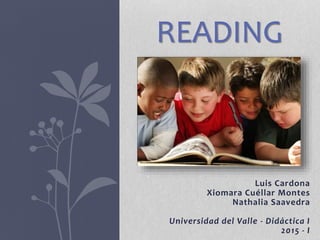
Reading skill
- 1. Luis Cardona Xiomara Cuéllar Montes Nathalia Saavedra Universidad del Valle - Didáctica I 2015 - I READING
- 2. CONTENTS 1. What is reading? 2. Extensive and intensive reading 3. Approaches of reading 4. Stages 5. The interactive Model of Literacy 6. Strategies 7. Reading aloud vs silent reading 8. Materials 9. Introducing new books 10. Book reviews and Criteria to choose a book 11. Activity
- 3. You will find the video link on the references.
- 4. Reading is a complex cognitive process of decoding symbols in order to construct or derive meaning (reading comprehension). It is a means of language acquisition, of communication, and of sharing information and ideas. Like all language, it is a complex interaction between the text and the reader which is shaped by the reader’s prior knowledge, experiences, attitude, and language community which is culturally and socially situated. READING
- 5. Extensive reading Teachers encourage students to choose a book and read it for pleasure. To encourage students to read: • Extensive reading materials. • Setting up a library. • The role of the teacher in extensive reading programmes. • Extensive reading tasks.
- 6. Intensive reading Teachers choose the books and direct the reading to develop specific receptive skills. • Intensive reading: the roles of the teacher. • Roles to adopt when asking students to read: • Organiser. • Observer. • Feedback organiser. • Prompter. • Intensive reading: the vocabulary question. • Do not worry about the meaning of every single word. • Time limit. • Word/phrase limit. • Meaning consensus.
- 7. • Intensive reading: letting the students in. • Do you like the text? • Reading lesson sequences. • Skimming: reading for gist or general understanding. • Scanning: reading for detailed comprehension or reading for inference and attitude. • Examples of reading sequences • Predict the content. • True or false. • Questions. • Definition of words. • Complete the text. • Put in order to make a story.
- 8. Approaches of reading • Phonics: It is based on letters and sounds. Teacher teaches the letter of the alphabet, and the combination of letters, phonically – as they are actually pronounced. • Look and say: It is based on words and phrases, and makes a lot of use of flashcards. • Whole sentence reading: The teacher teaches recognition of whole phrases and sentences which have meaning in themselves. • Language experience approach: It is based on the child’s spoken language. The teacher writes a sentence for the child to read which is based on what the child said. Which method to choose?
- 9. Stages • Five to seven years old • They are starting reading process in its mother language. • You should introduced them the different element related with reading process. • Vowels/ Sounds/ Words/ Sentences/ Paragraphs • Decoding reading • Through clues = Visual clues = Images • To take much more time. *Important note: There students who has as mother language one that is not base on the Roman script.
- 10. Stages • Eight-to ten- years-old • Those students already are able to read a bit in their own language. • Teachers spend much less time teaching them the mechanics of reading. • Time that you as teacher can invest in other activities.
- 11. Bottom up model of literacy To be able to read, besides decoding, one also needs to learn to guess or predict what the text is going to say. Read is thus a kind of “psychological game”. Developing literacy skills of young language learners
- 12. Top-down model of literacy Readers need to be able to activate the background knowledge and bring it to the reading process. Interative model of literacy
- 13. Using the whole language Learning to write and read in a SL should start as a whole not as a part
- 14. Creating a literate classroom enviroment Poster size pictionaries are helpful resources not pieces of decoration!
- 15. Language experience approach (LEA) and dictated stories 1. The teacher engages children in a group activity 2. Children describe the activity they just experience in their own words. 3. Teacher transcribes the stories as the children tell them 4. Children read the stories they have created
- 16. Literacy Scaffolds Pre-reading questioning Sentence patterns Pictionaries Graphic organizers Literacy blocks: 1. A sentence scaffold or a sentence starter 2. Word bank or pictionary (thematically related)
- 17. My Magic Pot My magic pot cooks_____ It also cooks____ To start cooking I say, “ ____” To stop cooking I say “____”
- 18. Reading aloud vs Silent Reading
- 19. Material • Reading cards • Home-made books • Book for native speakers of the language • Easy readers for foreign language learners • Pictures dictionaries • Book with tapes - Audio-books
- 20. Pre and Post Reading Introducing new books •A new book should not just appear! Book reviews •It is important to know what the children think about the book Criteria to choose a book •Stage •Student’s level •Goals of objectives that teacher wants get with students. •Syllabus and topic
- 21. ACTIVITY
- 23. Steps 1. Infer from the cover. 2. Infer from the title. 3. Students take a look at the book. 4. Identify the characters. 5. Start reading. 6. Stop almost at the end to predict the end. 7. Finish it. 8. Ask if they liked it. 9. Questions about vocabulary while reading. 10. Questions about the book.
- 24. References • Brewster, J., Ellis, G., Girard, D. (1992). The Primary English Teacher’s Guide, chapter 7, The written word. Hondon. Pinguin Books. • Harmer J. (2011) The practice of English Language Teaching, chapter 17, Reading. • Gordon, T. (2007). Teaching Young Children a Second Language, chapter 5, Developing Literacy Skills of Young Language Learners. Praegar. • Scott,W.,& ytreberg,L. (1990) Teaching English to Children, chapter 5, Reading. New York Longmar. • http://en.wikipedia.org/wiki/Reading_(process) • https://www.youtube.com/watch?v=5kB7GgLlR7M
Editor's Notes
- th